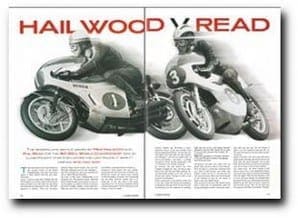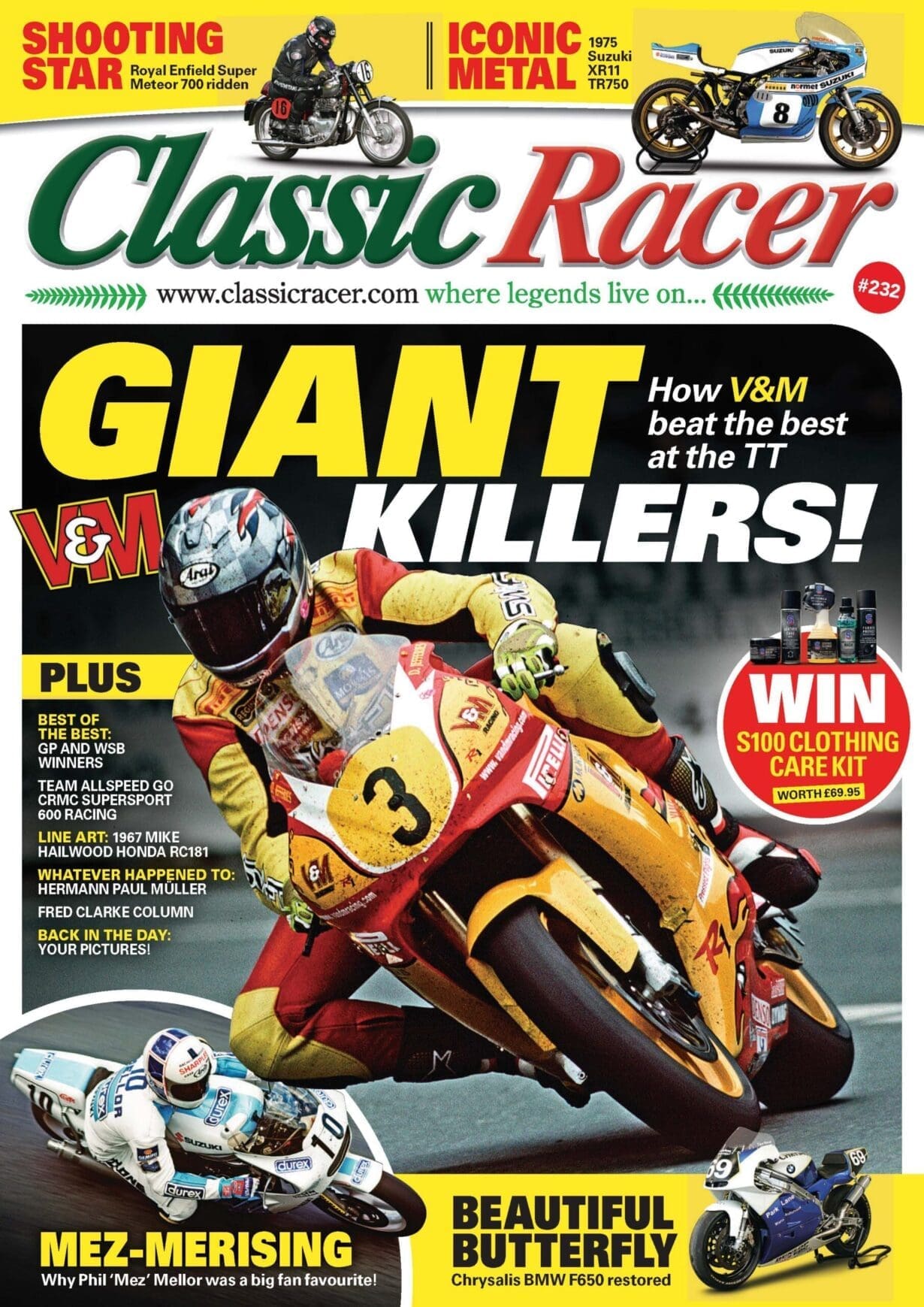
There have been some close finishes in the 50-year history of the World Championships, but none have been tighter or more chaotic than the 1967 250cc title chase.
In fact, it was so close and confused that the FIM steward at the final round of the series in japan refused to say who had won the series and referred the matter back to the FIM headquarters in Geneva. There the Secretary General, Major David Goode, first said that Phil Read (Yamaha) was the new champion and then changed his mind and awarded the title to Mike Hailwood (Honda)!
The story of that year's championship is an intriguing one. The previous season, Hailwood had re-joined Honda and stormed to victory on its six-cylinder 250 ahead of Read on the fast, but hard-to-handle, Yamaha. It was a walk-over. Mike won ten of the 12 classics and was never once beaten, scoring 80 points to Read's 34. Looking at those figures, the 1967 championship seemed little more that a formality, but behind the scenes two factors were working to shift the balance of power. First, Honda had run into deep financial trouble, due in no small part to the vast sums it had spent expanding its F1 car racing programme (which included signing John Surtees, previously with Ferrari, to lead the team).
 Second, Yamaha had developed a much-improved version of the four-cylinder RD05 (factory designation RD05A). The new bike was both lighter and lower than the 1966 machine and although it still did not handle quite as well as the Honda, it was faster — 153.8mph through the Motor Cycling speed-trap at the TT compared to the Honda's 145.8mph.
Second, Yamaha had developed a much-improved version of the four-cylinder RD05 (factory designation RD05A). The new bike was both lighter and lower than the 1966 machine and although it still did not handle quite as well as the Honda, it was faster — 153.8mph through the Motor Cycling speed-trap at the TT compared to the Honda's 145.8mph.
By contrast, the 1967 Honda was little changed. Strapped for cash, the factory gambled on the 1966 bike and Mike's brilliant riding being good enough to win the title for a second year without having to invest in the machine's development.
Battle commenced at the Spanish Grand Prix in late April. There the twisting and appallingly dangerous Montjuich Park circuit overlooking Barcelona put the emphasis on handling, acceleration and sheer guts rather than top speed. Mike and the six were in their element. With the help of a record lap, Hailwood built up a lead of half-a-minute over Read, and looked to have the race in the bag until his rear tyre punctured. Read took full advantage of the situation to take the win ahead of Mike's team-mate Ralph Bryans.
Mike was also out of luck at the second round, held a week later at Hockenheim, when his Honda developed a misfire, forcing his retirement after just two laps. This left Bryans to fight it out with Yamaha's Read and Bill Ivy, the latter retiring from the fray after setting a record lap.
Signal-board
Urged on by Mike, who went track-side with a signal-board indicating that Bryans should use more than the usual maximum revs to beat Read, the little Ulsterman rode one of the finest races of his career to win by four seconds.
Two weeks later, the battle moved to the French Grand Prix at the magnificent mountain circuit near Clermont-Ferrand. Few would have bet against Mike and the Honda on such a circuit, and sure enough, he streaked away and quickly built up a commanding lead with a blistering lap that beat the 5oocc record for the five-mile course. Then, for the third race in succession, the bike let him down. The gearbox began to fail and he eventually limped home in third place behind the two Yamahas Ivy winning from Read, with Bryans in fourth behind his team leader.
 This meant they went to the Isle of Man for the TT with Read leading the World Championship with 20 points to Bryans' 17 and Ivy's 8. Things were not looking good for Hailwood, who was trailing way behind in fourth place with just four points. The points system in those days was eight for a win, then six, four, three, two and one, down to sixth place. To confuse the issue, not every point counted. The formula was to divide the number of GPs by two and, ignoring fractions, add one, which meant that in a 12-round championship only a rider's seven best results would count. But we have not got to that stage yet! Things started badly for Mike in the Island when he was involved in a car crash as a passenger in Bill Ivy's new Ferrari. Bill lost control at speed in the Greeba area and ran the Ferrari into a stone wall. The car was extensively damaged, but fortunately both men were able to walk away. Ivy was later fined £12 by a Manx court for driving without insurance and the Ferrari was shipped home via Liverpool and Genoa for a £1,000 rebuild.
This meant they went to the Isle of Man for the TT with Read leading the World Championship with 20 points to Bryans' 17 and Ivy's 8. Things were not looking good for Hailwood, who was trailing way behind in fourth place with just four points. The points system in those days was eight for a win, then six, four, three, two and one, down to sixth place. To confuse the issue, not every point counted. The formula was to divide the number of GPs by two and, ignoring fractions, add one, which meant that in a 12-round championship only a rider's seven best results would count. But we have not got to that stage yet! Things started badly for Mike in the Island when he was involved in a car crash as a passenger in Bill Ivy's new Ferrari. Bill lost control at speed in the Greeba area and ran the Ferrari into a stone wall. The car was extensively damaged, but fortunately both men were able to walk away. Ivy was later fined £12 by a Manx court for driving without insurance and the Ferrari was shipped home via Liverpool and Genoa for a £1,000 rebuild.
 A few days later, Mike stormed to victory in the 250cc TT with race and lap records in the bag at 103.07mph and 104.50mph respectively. It was his tenth TT win, equalling the pre-war record of Stanley Woods, who was among the first to offer his congratulations.
A few days later, Mike stormed to victory in the 250cc TT with race and lap records in the bag at 103.07mph and 104.50mph respectively. It was his tenth TT win, equalling the pre-war record of Stanley Woods, who was among the first to offer his congratulations.
Tempering Hailwood's delight was the fact that Read finished second to boost his points total to 26, five ahead of Bryans, who finished third in the Island, and 14 in front of Hailwood. Ivy, who retired with engine trouble while holding third place, dropped to fourth.
At the next round, the Dutch TT, Mike won all three main classes — 250, 350 and 500cc — in a single day, covering 272.83 racing miles in around five hours and establishing yet another record, one unequalled to this day.
Read had flashed ahead from the 250cc start but Hailwood soon overtook him and, to Honda's delight, the Yamaha rider eventually retired with engine problems. Team-mate Ivy took second place, with Bryans third. Read still topped the table, but Bryans was just one behind on 25 and Mike was now a serious challenger with 20 — six points ahead of Ivy.
Belgian Grand Prix
At the Belgian Grand Prix, held the following weekend on the ultra-fast 8.8 mile SpaFrancorchamps circuit, the sheer speed of the Yamahas told. Read and Ivy set the pace in training, a morale-shattering four seconds ahead of Mike. His plan to slipstream the Yamahas having failed, Mike appeared to settle for third place but was promoted to second when race-leader Read retired, leaving Ivy through to win at 122.35mph. Bryans took third and moved to the top of the table with 29 points. Read and Hailwood had 26 apiece, four ahead of Ivy.
 Read won the next round at the Sachsenring in East Germany where Mike's Honda wilted under the strain of trying to stay with the Yamaha. The Yamahas were again supreme in Czechoslovakia, Read taking the honours here ahead of Ivy, Hailwood and the consistent Bryans.
Read won the next round at the Sachsenring in East Germany where Mike's Honda wilted under the strain of trying to stay with the Yamaha. The Yamahas were again supreme in Czechoslovakia, Read taking the honours here ahead of Ivy, Hailwood and the consistent Bryans.
The contestants travelled to Imatra for the Finnish Grand Prix with Read comfortably ahead on 42 points, followed by Ivy on 34, Bryans with 33 (now losing points to the 'half plus one' ruling) and Hailwood on 30. Things were looking grim for the Hailwood camp.
 The weather at Imatra was appalling, torrential rain flooding the track. Despite crashing in the preceding 500cc race, Mike proved the master in the 250cc event, winning by over a minute from Ivy while both Read and Bryans retired with mechanical problems. When the points were calculated, just four covered the top three places: Read 42, Ivy 40 and Hailwood 38. Read was fastest in practice for the Ulster but Hailwood was first away. When the Yamaha caught and passed him, it looked as though the Dunrod crowd was in for a thriller, but it was not to be. What promised to be an epic encounter came to a sudden end when Read locked his front wheel and went down at the hairpin as he tried to counter Hailwood's bid to outbrake him.
The weather at Imatra was appalling, torrential rain flooding the track. Despite crashing in the preceding 500cc race, Mike proved the master in the 250cc event, winning by over a minute from Ivy while both Read and Bryans retired with mechanical problems. When the points were calculated, just four covered the top three places: Read 42, Ivy 40 and Hailwood 38. Read was fastest in practice for the Ulster but Hailwood was first away. When the Yamaha caught and passed him, it looked as though the Dunrod crowd was in for a thriller, but it was not to be. What promised to be an epic encounter came to a sudden end when Read locked his front wheel and went down at the hairpin as he tried to counter Hailwood's bid to outbrake him.
Mike avoided the sliding bike and rider and went on to win ahead of Bryans. Ivy had chased hard for a few laps before being slowed by a misfire which forced him to settle for third. Hailwood's win put him on top of the 250cc table for the first time with 46 points, two ahead of Ivy and four in front of Read. But the battle was far from over.
Italian at Monza
The next round was the Italian at Monza. As in Belgium, the ultra-fast going favoured the Yamahas. Mike tried to slipstream them but the pace proved too much for the six-cylinder engine and he retired covered in oil. This success put Read back on top with 5o points, four head of Mike with just two rounds to go — the Canadian Grand Prix and the Japanese round at Fuji.
The race in Canada was held on the 2.5-mile purpose-built Mosport Park circuit near Toronto, but a combination of bitterly cold wet weather allied to a track made slippery by a recent long-distance sports car race, made it a tricky affair. Both Read and Bryans crashed during practice and although they started the race, it was Ivy who pushed Hailwood hard until his Yamaha engine exploded with just a lap to go.
 This let Read through to finish second, which under the scoring system of the time did not add a single point to his total because only his best seven results counted. This meant that he and Hailwood, who both flew overnight from Canada to win races at Brands Hatch the next day, went to Japan tying for the championship lead with 50 points apiece.
This let Read through to finish second, which under the scoring system of the time did not add a single point to his total because only his best seven results counted. This meant that he and Hailwood, who both flew overnight from Canada to win races at Brands Hatch the next day, went to Japan tying for the championship lead with 50 points apiece.
The situation appeared straightforward. Victory for either man would clinch the title. Between them, Hailwood and Read had won nine of the 12 rounds and it was odds on that one or other would be standing on top of the rostrum. It wasn't to be — and that's when things started to get complicated.
Honda armed Mike with a shorter stroke version of the six-cylinder RC166 for the all-important showdown. This had a bore and stroke of 41 x 3I.5mm compared to the 39 x 34.8mm dimensions of the original model, revved to 18,000 and developed 60bhp, five more than the old engine.
During the race, the worst case scenario occurred when first Read, who made a poor start, retired with a broken crankshaft, and Hailwood pulled into the pits with a misfire and retired. Ivy took over and looked certain to win until his Yamaha failed with just four of the 33 laps left to cover, leaving Bryans to take the chequered flag, a win that clinched the manufacturers' title for Honda with 56 points to Yamaha's 54.
Individual champion
But who was the individual champion? Honda claimed it was Hailwood's because he had five race wins to Read's four. Yamaha reckoned Read had regained the title he won for them in 1964 and 1965 on the basis that ties on 'significant' points were decided by taking each rider's eighth best performance into account, which gave him a two-point advantage over Hailwood. FIM steward Otto Sensburg refused to give a ruling. He rightly claimed that the English and French texts of the FIM rule book differed and passed the buck to the FIM headquarters in Geneva. The Secretary-General Goode at first sided with the Yamaha interpretation of the regulations and said that Read was the new champion.
 Acting on this seemingly official information, Motor Cycle – the paper I worked for at the time – ran the headline: 'Read Tops in Title Tangle'. Rivals MCN took the opposite view and they were right!
Acting on this seemingly official information, Motor Cycle – the paper I worked for at the time – ran the headline: 'Read Tops in Title Tangle'. Rivals MCN took the opposite view and they were right!
A day after he spoke to us, Goode changed his mind. He discovered that in 1964 the rules had been revised, and that from 1965 ties on 'significant' points were to be decided on the basis of which rider had the most outright wins. Why had the confusion arisen? Simply because the new ruling had never been published in the English version of the FIM code, although it was in the French. Ironically if today's system applied with every point counting, the 1967 250cc World Champion would have been the consistent Ulsterman Ralph Bryans who finished in 12 of the 13 races and scored a total of 58 points; two more than Read and four more than Hailwood. ![]()




